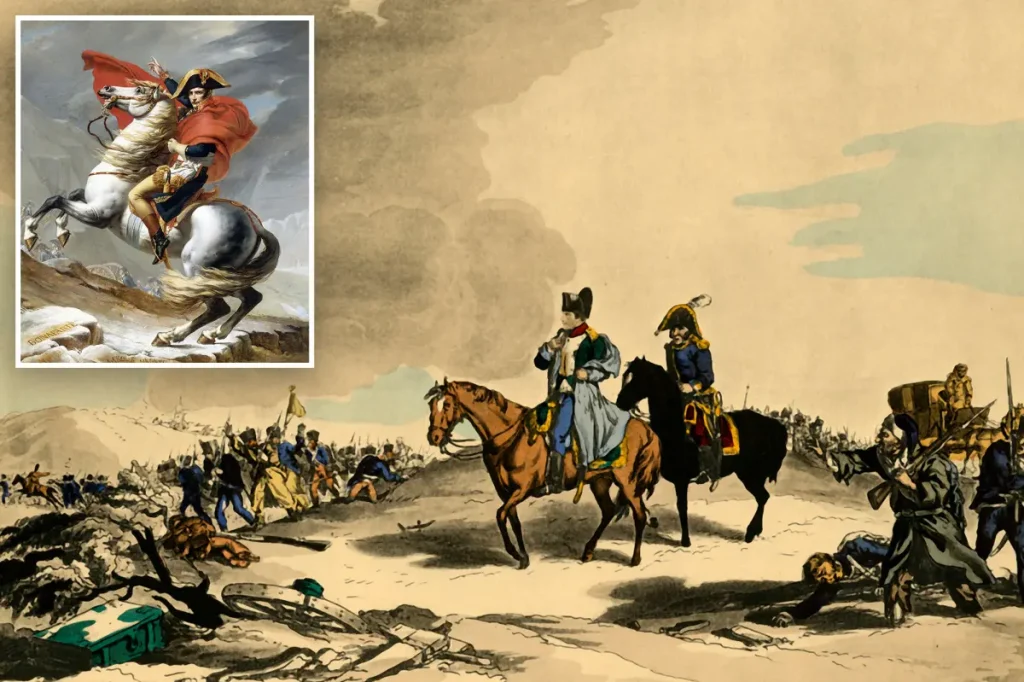Napoleon’s Forgotten Killers: New Study Reveals Fatal Pathogens That Decimated French Troops
In a groundbreaking discovery that sheds new light on one of history’s most infamous military disasters, scientists have identified deadly bacterial pathogens that contributed to the decimation of Napoleon Bonaparte’s Grande Armée during the catastrophic 1812 retreat from Russia. Published in the journal Current Biology, this remarkable study analyzed DNA extracted from the teeth of French soldiers buried in mass graves in Vilnius, Lithuania, revealing hidden killers that worked alongside the notorious Russian winter to bring the French emperor’s ambitions to a devastating end. By examining these centuries-old remains, researchers have finally put names to the invisible enemies that historians have long suspected played a crucial role in one of history’s most dramatic military collapses. The findings offer a sobering reminder of how disease, hunger, and extreme weather can combine to defeat even the most formidable military force.
The study centered on a mass grave in Vilnius that contains up to 3,000 French soldiers who perished during Napoleon’s retreat. Using advanced DNA analysis techniques, researchers examined teeth from 13 soldiers and made a startling discovery: four tested positive for bacteria causing paratyphoid fever, while two others showed evidence of louse-borne relapsing fever. These findings are particularly significant because neither pathogen had previously been conclusively identified among Napoleon’s troops, despite centuries of historical investigation into the campaign. “Many soldiers arrived exhausted, starving and ill,” explained study author Nicolás Rascovan, a microbiologist who spoke with Reuters. “A substantial number died there and were interred rapidly in mass graves.” These hasty burials preserved crucial biological evidence that has now revealed secrets hidden for over two centuries, allowing scientists to confirm what historical accounts could only suggest about the horrific conditions faced by these soldiers.
The identification of these specific pathogens paints a vivid picture of the desperate conditions endured by Napoleon’s once-mighty army. Paratyphoid fever, spread through contaminated food and water, and relapsing fever, transmitted by body lice, both cause debilitating symptoms including high fever, severe headaches, and extreme weakness. These infections would have spread rapidly through the ranks of soldiers already weakened by starvation and exposure to subfreezing temperatures. The co-occurrence of diseases with different transmission routes underscores the catastrophic breakdown in sanitary conditions during the retreat. As Napoleon’s supply lines collapsed and discipline disintegrated, his soldiers found themselves not only fighting Russian forces but also battling invisible enemies that spread through their cramped quarters, contaminated water supplies, and even on their unwashed bodies. The study provides compelling evidence that these infectious diseases played a significant role in the estimated 300,000 French deaths during this ill-fated campaign.
The disaster that befell Napoleon’s Grande Armée represents one of history’s most dramatic reversals of fortune. After initially marching triumphantly into Moscow in September 1812, Napoleon found himself without a clear victory when Tsar Alexander I refused to surrender and the Russian forces adopted a scorched-earth strategy. With winter approaching and supplies dwindling, Napoleon was forced to order a retreat in October. What followed was one of history’s most notorious military catastrophes, as the once-mighty French force faced relentless harassment from Russian troops, temperatures that plunged to -30°C (-22°F), and increasingly desperate conditions. The new research helps explain why so many soldiers succumbed even before facing direct combat with Russian forces. The combined effects of starvation, extreme cold, and multiple infectious diseases created a perfect storm of suffering from which few could escape. By the time the remnants of Napoleon’s army staggered across the Niemen River in December, only about 10,000 effective fighters remained from an invasion force that had numbered around 450,000.
This study represents a triumph of modern scientific methods applied to historical mysteries. “Studying ancient DNA lets us put names to infections that symptom-based accounts alone cannot resolve,” Rascovan explained. While contemporary observers and subsequent historians documented the visible suffering of Napoleon’s troops, they lacked the tools to identify specific pathogens with certainty. The research team employed sophisticated genomic techniques to detect and analyze bacterial DNA preserved in dental pulp chambers for over two centuries. This allowed them to identify not just the presence but also the specific strains of bacteria afflicting these soldiers. Such precision would have been unimaginable to the physicians who treated the dying men in 1812, yet it provides crucial context for understanding the full scope of the disaster. The research team has indicated that this work represents just the beginning, noting that “future work across more sites and individuals will refine the disease landscape of 1812.”
The findings from this study resonate beyond purely historical interest, offering sobering lessons about the interplay between warfare, disease, and environmental extremes that remain relevant today. Napoleon’s campaign collapsed not primarily from battlefield defeats but from a catastrophic failure to account for logistical challenges, environmental conditions, and the inevitable spread of disease among troops facing deteriorating conditions. The study serves as a powerful reminder that military planners throughout history have often underestimated the threat posed by infectious disease—a mistake that has sometimes proven more costly than enemy action. By identifying the specific pathogens that contributed to this historic disaster, researchers have added an important chapter to our understanding of how disease has shaped human conflicts and empires. As Rascovan and his colleagues continue their work analyzing remains from other sites along Napoleon’s retreat route, they promise to further illuminate this pivotal moment when a seemingly invincible emperor was undone not just by Russian resistance and winter cold, but by microscopic enemies his era’s science could barely comprehend.















